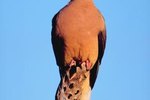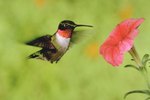
The American robin is a favorite among birdwatchers, according to "Birds and Blooms" magazine. The robin forages for worms and fruit just about anywhere in North America. They may migrate south between fall and winter, but not for the reasons you may think.
About the Robin
The American robin, one of several known commonly as robin redbreast, is Turdus migratorius. It is recognizable by its colorful breast plumage. Robins live on average only 18 months but can live up to five years. The female is not as colorful as the male, and her singing talent is restricted to alarm calls and a few notes. Robins eat worms and insects as well as fruit and berries. Their fondness for fruit and berries drives them to migrate south in the fall. The warm climate is not so much the lure as is the preponderance of insects, fruits and berries to the south cause them to fly away from their familiar territory.
Migratory Habits
Robins are not creatures of habit, so their patterns of migration are hard to follow and understand. They migrate to find fruit and berries when the snow covers the ground, cutting off their supply of worms. Insects don't survive cold winters and are not as plentiful in the native geography as they are in the spring and summer. So robins tend to fly to all points south, but not in any particular migratory path. While other birds follow the same migratory path year after year, robins flock together and travel south looking for trees and bushes bearing fruit and berries. When they spot them, they swoop in for a feast, then stick around looking for other food sources. The number of robins in any one area varies from year to year.
Feeding Habits
Robins' feeding habits direct their movements. Robins can eat up to 14 worms in one day. They are able to find earthworms by cocking their heads to the side and using their monocular vision, rather than by listening as some bird experts previously thought. They are frequent guests of backyards, golf courses, forests, parks and farms. When people who enjoy watching them don't see them for a while, they assume the robins have flown south for the winter. In fact, the robins have not gone far. They simply changed their hunting and foraging methods.
Robin Movement
Robins move in flocks, as do most birds. Flocking together helps them protect themselves because they can all watch out for predators together, and one will alert the rest of the group if a hawk or other bird of prey appears. These flocks can number in the thousands; when a flock that huge descends on an area, birders take note. Those participating in the Great Backyard Bird Count, an effort to keep track of birds and learn more about them, report such sightings. Robins are known to avoid areas of deep snow, but scientists at the Cornell University of Ornithology believe the avoidance has more to do with the fact that they can't find insects under the snow rather than an aversion to the cold.
References
- Cornell University College of Orinthology: Migration
- Birds and Blooms: Do Robins Really Return in the Spring
- Birds and Blooms: American Robin
- Wild Birds Unlimited: Educational Resources
- All About Birds: American Robin
- Indiana Department of Natural Resources: Sandhill Cranes During Their Fall Migration
Photo Credits
-
Jupiterimages/liquidlibrary/Getty Images
Writer Bio
Michelle A. Rivera is the author of many books and articles. She attended the University of Missouri Animal Cruelty School and is certified with the Florida Animal Control Association. She is the executive director of her own nonprofit, Animals 101, Inc. Rivera is an animal-assisted therapist, humane educator, former shelter manager, rescue volunteer coordinator, dog trainer and veterinary technician.




